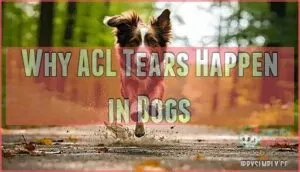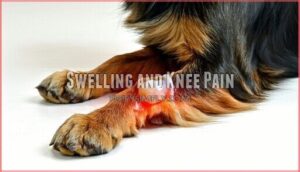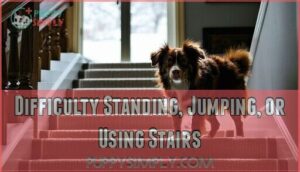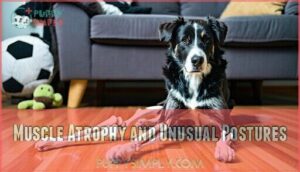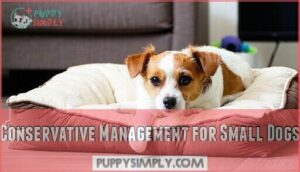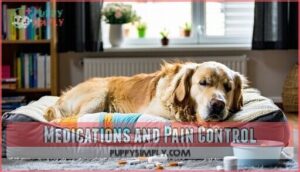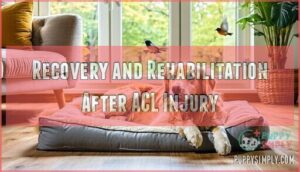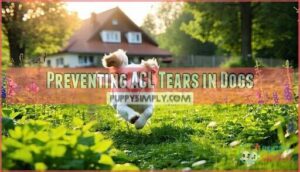This site is supported by our readers. We may earn a commission, at no cost to you, if you purchase through links.
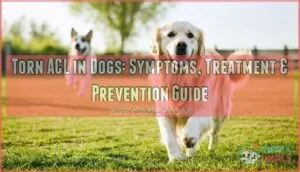
This common orthopedic problem affects up to 600,000 dogs annually, causing symptoms like sudden limping, swelling, and difficulty jumping or climbing stairs.
While 85% result from sudden trauma during activities like running or turning, 80% actually stem from chronic degeneration over time.
Treatment ranges from conservative management with rest and pain relief for smaller dogs to surgical options like TPLO or TTA for larger breeds.
Early intervention and proper rehabilitation substantially improve outcomes, but understanding the subtle warning signs can make all the difference in your dog’s recovery timeline.
Table Of Contents
- Key Takeaways
- What is a Torn ACL in Dogs?
- Why ACL Tears Happen in Dogs
- Dog Breeds and Risk Factors for ACL Tears
- Symptoms of a Torn ACL in Dogs
- How Vets Diagnose ACL Tears in Dogs
- Treatment Options for Torn ACL in Dogs
- Comparing Partial and Complete ACL Tears
- Recovery and Rehabilitation After ACL Injury
- Preventing ACL Tears in Dogs
- Frequently Asked Questions (FAQs)
- What are the treatment options for a dog with a torn ACL?
- What are the symptoms of a dog with a torn ACL?
- How long does it take for a dog to recover from a torn ACL?
- What dog breeds are most prone to ACL injuries?
- Can a torn ACL in dogs heal on its own without any intervention?
- Can both ACL tears happen at once?
- How much does ACL surgery typically cost?
- Whats the success rate for ACL surgery?
- How long before my dog walks normally?
- Are there alternatives to expensive surgery options?
- Conclusion
Key Takeaways
- You’ll spot torn ACLs through sudden limping, swelling, and difficulty with stairs or jumping – these symptoms often appear without warning during normal activities like running or playing.
- Large breeds like Labs, Golden Retrievers, and German Shepherds face the highest risk – up to 80% of cases result from chronic degeneration rather than sudden trauma, especially in dogs neutered before 12 months.
- Treatment depends on your dog’s size and injury severity – small dogs under 30 pounds often heal with rest and medication, while larger dogs typically need surgical options like TPLO or TTA.
- Early intervention and weight management are crucial for recovery – maintaining proper weight reduces injury risk by preventing extra stress on knee joints, while prompt treatment improves long-term outcomes significantly.
What is a Torn ACL in Dogs?
Your dog’s ACL tear affects the cranial cruciate ligament, which stabilizes the knee joint by preventing the shinbone from sliding forward under the thighbone.
This vital ligament bears weight whenever your dog stands since their knees naturally bend, making it vulnerable to both sudden injuries and gradual wear over time.
Definition of ACL and CCL in Dogs
In dogs, the ACL and CCL refer to the same essential structure—your dog’s cranial cruciate ligament.
While humans have an "anterior" cruciate ligament (ACL), dogs have a "cranial" cruciate ligament (CCL) due to their four-legged stance.
This important ligament ensures joint stability and proper stifle mechanics, making it the cornerstone of canine orthopedics and knee anatomy.
Function of The Cranial Cruciate Ligament
Your dog’s cranial cruciate ligament (CCL) acts like a sturdy anchor, preventing the tibia from sliding forward during movement.
This ligament stability keeps your pup’s knee functioning smoothly when they’re standing, walking, or running.
Without proper cruciate function, the stifle mechanics break down, causing painful joint structure problems.
The CCL bears significant weight when your dog stands since their knee stays naturally bent, making this canine knee injury particularly challenging when cruciate ligament injury occurs, affecting the overall stifle mechanics.
Anatomy of The Dog’s Knee Joint
The canine knee joint, or stifle, functions like a complex hinge connecting your dog’s femur to the tibia and fibula.
The cranial cruciate ligament provides essential knee joint stability by preventing forward sliding of the tibia.
C-shaped meniscus cartilage acts as shock absorbers between bones.
Tibial slope angles affect ligament function and joint stability, making proper knee structure essential for your dog’s mobility and comfort.
Why ACL Tears Happen in Dogs
Understanding why your dog’s ACL tears can help you recognize warning signs and take preventive steps.
ACL injuries in dogs typically result from three main factors: sudden trauma, gradual wear-and-tear, or genetic predisposition combined with age-related changes.
Acute Trauma and Sudden Movements
About 85% of canine stifle injuries result from acute trauma during everyday activities.
Most canine knee injuries happen during everyday play and movement, not extreme sports
Your dog’s cranial cruciate ligament can snap instantly when they experience:
- Sudden Stops while running at full speed
- Quick Turns during play or chasing
- Traumatic Falls from furniture or stairs
- High Impact landings from jumps
- Sharp Twists when changing direction rapidly
These moments create forces that exceed the ligament’s strength, causing immediate torn acl in dogs and triggering severe dog knee pain requiring canine orthopedic surgery.
Chronic Degeneration and Micro-Injuries
Unlike sudden tears that happen in a flash, most cruciate ligament injuries build up slowly through repeated micro tears and ligament wear.
Your dog’s CCL gradually weakens from countless small stresses during normal activities, creating joint instability and chronic pain. This degenerative process affects up to 80% of torn ACL cases, with inflammation and degenerative changes occurring months before the final rupture in canine orthopedic surgery cases.
Understanding common health issues like golden retriever problems is vital for identifying potential risks and taking preventive measures to protect your dog’s joints and overall health.
Age, Genetics, and Anatomical Factors
Several factors beyond your dog’s daily activities contribute to cranial cruciate ligament vulnerability.
Age-related degeneration weakens ligament fibers over time, while genetic predisposition affects certain breeds differently.
Key anatomical factors increasing torn ACL risk in dogs:
- Steep tibial slope angles create abnormal joint stress
- Genetic factors influence ligament strength and structure
- Breed characteristics like body weight distribution
- Age-related risks from natural tissue deterioration
- Anatomical abnormalities affecting knee joint alignment
These inherited and developmental factors explain why some dogs face higher risks despite similar activity levels.
Dog Breeds and Risk Factors for ACL Tears
Your dog’s breed substantially influences their ACL tear risk, with some breeds facing up to four times higher chances of injury.
Factors like early neutering, obesity, and irregular exercise patterns can further increase your pet’s vulnerability to this common orthopedic problem, specifically an ACL tear.
Breeds Prone to ACL Injuries
Certain large breed dogs face dramatically higher risks for torn ACLs.
Labradors account for 12% of all canine cruciate ligament ruptures reported annually, while Rottweilers show three times the injury rate of mixed breeds.
German Shepherds and Golden Retrievers also top the list, with lifetime injury rates reaching 5-7%.
These breeds’ size and genetics create the perfect storm for ligament failure.
Early Neutering and Hormonal Influences
Early spaying or neutering before 12 months can set the stage for future cruciate ligament injury.
Timing your puppy’s spay or neuter could determine their future joint health
Hormone Impact affects Growth Plates closure, potentially altering bone development and Joint Stability.
Studies show Sex Differences matter – 5% of males and 8% of females neutered early develop CCL tears later.
Neutering Effects may compromise natural joint mechanics, increasing susceptibility to cruciate ligament injury in canine orthopedics.
Understanding the risks of neutering your dog is vital for preventing such injuries and ensuring the overall health of the animal.
Activity Level and “Weekend Warrior” Syndrome
Beyond genetics, your dog’s exercise habits play a major role in ACL injury risk.
Weekend warriors—dogs who go from couch potato to marathon hiker overnight—face substantially higher injury rates than consistently active pets.
Key Exercise Risks for ACL Injuries:
- Sudden activity spikes – Going from minimal exercise to intense weekend adventures stresses unprepared joints and muscles
- Poor conditioning combined with high-impact sports – Agility, frisbee, and ball chasing without proper fitness preparation increase vulnerability
- Obesity paired with sporadic exercise – Extra weight on deconditioned joints creates a perfect storm for ligament failure
Symptoms of a Torn ACL in Dogs
If you notice your dog suddenly limping or favoring one hind leg, they might’ve torn their ACL.
These injuries cause immediate pain and instability, making it difficult for your pet to put full weight on the affected leg.
Limping and Sudden Lameness
You’ll recognize torn ACL in dogs when they suddenly start favoring one back leg.
This hindleg lameness often appears without warning – your dog might be running normally one moment, then limping the next. Knee instability creates obvious leg weakness that worsens with movement.
| Lameness Type | Appearance | Activity Level |
|---|---|---|
| Mild | Slight limp, weight-bearing | Reduced but present |
| Moderate | Obvious limping, partial weight | Limited movement |
| Severe | Three-legged gait, no weight | Minimal activity |
Sudden onset joint pain makes dogs reluctant to put full weight on the affected limb, creating the characteristic "toe-touching" gait you’ll notice during walks.
Swelling and Knee Pain
Your dog’s knee inflammation becomes obvious when you spot firm swelling on the inside surface of the affected joint.
This medial buttress, combined with visible joint instability, appears in 70% of confirmed torn acl in dogs cases.
Knee pain in dogs manifests through reluctance to bear weight and sensitivity during examination.
Proper pain management becomes essential as ligament tear progresses, requiring immediate veterinary assessment for effective injury rehabilitation.
Difficulty Standing, Jumping, or Using Stairs
When your dog’s knee injury worsens, you’ll notice they struggle with basic movements like standing up from lying down or climbing stairs.
Torn ACL in dogs creates significant mobility issues, making jumping onto furniture nearly impossible.
Joint pain from knee instability forces dogs to avoid activities they once enjoyed, and difficulty standing becomes obvious after rest periods, requiring stair assistance for multi-level homes.
Decreased range of motion signals the need for canine rehabilitation to restore function, addressing the mobility issues that have developed.
Muscle Atrophy and Unusual Postures
When you’re dealing with a torn ACL, muscle loss becomes noticeable within weeks of decreased activity.
Your dog’s affected leg will appear thinner as muscles shrink from lack of use.
You’ll notice gait abnormalities and posture changes – they might sit with the injured leg extended sideways or struggle with joint instability when standing, making atrophy prevention essential through gentle movement.
How Vets Diagnose ACL Tears in Dogs
When your dog shows signs of limping or knee pain, your vet will perform specific diagnostic tests to confirm an ACL tear.
These examinations include physical manipulation of the joint, imaging studies, and specialized stability tests that reveal the extent of ligament damage.
Physical Examination and Gait Observation
When examining dogs with suspected cranial cruciate ligament injuries, your veterinarian will conduct an exhaustive orthopedic exam focusing on gait analysis and joint mobility assessment.
They’ll observe how your dog walks, noting any lameness in dogs or compensatory movements that indicate knee instability.
During the muscle assessment portion, your vet will check for atrophy and range of motion before performing specific tests.
Understanding the torn ACL diagnosis is vital for determining the best course of treatment and ensuring the dog’s quality of life.
Drawer Sign and Tibial Thrust Tests
Your vet will perform specific diagnostic tests to confirm knee instability and joint laxity.
The cranial drawer test checks if your dog’s tibia slides forward when the femur is stabilized, creating a "drawer sign" that indicates a torn ACL.
The tibial thrust test applies pressure to detect abnormal movement in the cranial cruciate ligament, making these diagnostic tests essential for diagnosing knee injury in dogs.
Radiographs and Advanced Imaging
X-rays can’t show torn ligaments directly, but they’ll reveal telltale signs like joint swelling and arthritis that develop in 90% of chronic cases.
Your vet might recommend advanced imaging like MRI scans or CT imaging for complex injuries, while diagnostic ultrasound offers excellent sensitivity for partial tears.
- Veterinary X-rays detect secondary signs like bone spurs and abnormal positioning rather than the actual ligament
- Canine MRI provides detailed soft tissue visualization when standard imaging proves inconclusive
- Joint arthroscopy serves as the gold standard for direct visualization and simultaneous surgical intervention
For accurate diagnosis, understanding dog ligament injuries is vital in determining the best course of treatment.
Assessing Meniscal Injury
Meniscal damage often accompanies cranial cruciate ligament CCL tears, occurring in up to 50% of cases.
Your vet will carefully assess the meniscus—those C-shaped cartilage cushions—during examination since a meniscus tear can complicate joint stability and tissue healing.
Think of it as checking both the broken door hinge and the doorframe itself for complete repair.
Treatment Options for Torn ACL in Dogs
When your dog tears their ACL, you’ll face several treatment paths depending on the injury’s severity and your pet’s size.
Treatment ranges from conservative rest and medication for smaller dogs to advanced surgical procedures that can restore full mobility and prevent arthritis.
Conservative Management for Small Dogs
Conservative treatment works best for small dogs under 30 pounds with torn ACL injuries.
Your vet will likely recommend this non-surgical approach when the tear isn’t complete or your pup’s size allows natural healing.
Rest therapy and conservative care include:
- Strict confinement – Your furry friend needs 6-8 weeks of limited activity (no running, jumping, or playing fetch)
- Pain relief medications – Anti-inflammatory drugs like carprofen help manage canine joint pain and swelling
- Weight management – Even a few extra pounds stress that healing ligament in small breeds
This conservative treatment approach helps many small dogs avoid surgery while their joint naturally stabilizes.
Surgical Stabilization Techniques
For larger dogs or those with complete tears, surgical options provide the best chance at restoring normal function.
TPLO surgery changes your dog’s knee geometry by rotating the tibial plateau, eliminating the need for the torn ligament.
TTA procedure advances the tibial tuberosity forward, redirecting forces to stabilize the joint, and Extracapsular suture stabilization uses strong sutures for external support.
According to recent studies on surgical gold standards, TPLO is often considered the preferred method for treating cranial cruciate ligament tears in dogs, providing a best chance at recovery.
Medications and Pain Control
Pain management alongside surgery helps your dog stay comfortable throughout recovery.
Your vet will prescribe medications to control inflammation and discomfort during the healing process.
Key Pain Relief Medications:
- NSAIDs – Anti-inflammatory medications like meloxicam, carprofen, or robenacoxib reduce swelling and pain
- Multimodal analgesia – Combining different pain relief approaches for maximum comfort
- Short-term opioids – Prescribed for severe post-surgical pain management
- Joint supplements – Support cartilage health and reduce inflammatory responses
Understanding the role of NSAID medications is essential for effective pain management in dogs with torn ACLs.
Stem Cell Therapy and Regenerative Approaches
Harnessing your dog’s own healing power, stem cell therapy offers a cutting-edge approach to treating torn ACLs.
Veterinarians extract stem cells from your pet’s fat or bone marrow, then inject them into the damaged joint to reduce inflammation and promote tissue regeneration.
| Treatment Aspect | Stem Cell Therapy Benefits |
|---|---|
| Inflammation Reduction | Naturally suppresses joint inflammation |
| Tissue Repair | Accelerates cartilage and ligament healing |
| Recovery Time | May shorten rehabilitation period |
Comparing Partial and Complete ACL Tears
ACL tears in dogs aren’t always complete breaks—partial tears occur when only some ligament fibers rupture, while complete tears involve the entire ligament.
Understanding the difference helps you recognize symptoms and make informed treatment decisions with your veterinarian.
Signs of Partial Versus Complete Tears
Partial tears typically create intermittent lameness signs that worsen after activity, while complete cranial cruciate ligament tears cause sudden, severe dog knee injury with non-weight bearing limbs.
You’ll notice subtle joint instability and minimal swelling with partial canine joint injury, but complete acl tear symptoms include pronounced instability, marked swelling, and intense pain levels during examination, requiring immediate veterinary attention.
Treatment Differences and Prognosis
Surgical outcomes and recovery times differ substantially between partial and complete torn ACL in dogs, impacting both treatment costs and rehabilitation methods.
Complete tears typically require immediate canine ACL surgery success, while partial injuries might benefit from conservative management initially.
Prognostic factors vary considerably between these presentations.
Treatment approaches differ based on severity:
- Complete tears demand surgical intervention within weeks to prevent permanent joint damage and guarantee the best dog ACL surgery outcomes
- Partial tears allow trial periods of rest and anti-inflammatory treatment, potentially avoiding surgery costs entirely
- Recovery timelines extend 12-16 weeks for surgery versus 6-8 weeks for successful conservative cruciate ligament injury management
Recovery and Rehabilitation After ACL Injury
Your dog’s recovery from ACL surgery requires patience and careful management to guarantee the best possible outcome.
The rehabilitation process typically spans 8-12 weeks and involves structured rest periods, controlled exercise, and gradual return to normal activity levels.
Post-Operative Care and Rest
Why does your dog’s surgery success depend on those vital first weeks?
PostOp recovery requires strict rest techniques and careful wound care monitoring. Your veterinary recommendations will include pain management protocols and limited movement to guarantee proper joint stability.
During this critical period, you’ll need to restrict jumping, running, and stairs while following specific canine rehabilitation guidelines that prepare your pet for upcoming rehabilitation exercises, ensuring proper joint stability.
Physical Therapy and Home Exercises
After your dog’s surgery, physical therapy becomes your best ally for recovery.
Targeted exercise routines help restore joint mobility while preventing muscle loss during the rehabilitation period.
- Passive range of motion exercises – Gently flex and extend your dog’s knee joint daily to maintain 80-90% flexibility
- Controlled leash walks – Short, slow walks on soft surfaces reduce re-injury risk by 15% compared to unrestricted movement
- Sit-to-stand repetitions – Practice 5-10 repetitions per session to boost quadriceps strength by approximately 20%
- Balance board training – Use wobble cushions to improve proprioception scores by 15% in rehabilitation groups
- Hydrotherapy sessions – Gentle water exercises enable dogs to recover up to 95% of pre-injury limb function
Professional canine rehabilitation specialists design customized protocols based on your dog’s size and injury severity.
Dogs receiving supervised physical rehab sessions show 30-40% greater improvement in gait analysis compared to unsupervised home care alone.
Utilizing proper rehab equipment is essential for effective rehabilitation and preventing further injury.
Preventing Re-Injury and Monitoring Progress
After completing physical therapy exercises, you’ll need to watch your dog like a hawk to catch any signs of setback.
Look for new limping, swelling, or reluctance to move—these red flags mean it’s time to pump the brakes on activity.
| Warning Signs | Action Required |
|---|---|
| New limping or favoring leg | Contact vet immediately |
| Joint swelling returns | Reduce activity level |
| Reluctance to exercise | Schedule progress check |
Recovery strategies for torn ACL in dogs require patience and vigilance.
Progress monitoring through regular vet visits guarantees your rehabilitation plans stay on track.
Post op care doesn’t end after surgery—injury prevention becomes a lifelong commitment to protect that repaired knee joint.
Preventing ACL Tears in Dogs
While you can’t completely prevent ACL tears in dogs, maintaining proper weight and exercise habits substantially reduces your pet’s risk.
Focus on consistent daily activity rather than weekend warrior sessions, and watch for early warning signs during regular vet visits.
Weight Management and Proper Exercise
Maintaining proper weight and exercise routines forms your strongest defense against ACL injuries.
Obesity quadruples tear risk, while controlled fitness training builds supportive muscle strength around joints.
- Diet Planning: Monitor caloric intake and portion sizes to prevent weight gain that stresses knee joints
- Exercise Routine: Implement gradual conditioning with low-impact activities like swimming and controlled walking
- Weight Control: Maintain ideal body condition score through consistent monitoring and veterinary guidance
Regular fitness training strengthens muscles supporting the stifle joint, reducing injury risk substantially.
Proper dog obesity prevention is vital for maintaining overall health and reducing the risk of ACL tears in dogs.
Joint Health Supplements and Nutrition
Supplementing your dog’s diet with joint-supporting nutrients can strengthen ligaments before problems develop.
Omega Fats from fish oil reduce joint inflammation by 30%, while glucosamine increases cartilage thickness by 25%.
Quality veterinary joint supplements containing these compounds show measurable benefits in 62% of dogs.
| Supplement Type | Clinical Benefit |
|---|---|
| Omega-3 Fatty Acids | 30% reduction in joint inflammation markers |
| Glucosamine | 25% increase in joint cartilage thickness |
| Chondroitin Sulfate | 41% decrease in lameness scores after 12 weeks |
| Green-Lipped Mussel | 55% of dogs showed measurable pain relief |
When choosing canine joint supplements, work with your vet to guarantee supplement safety and proper dosing.
High-quality dog joint health supplements with verified potency deliver consistent results, while nutrient balance in your canine diet provides the foundation for healthy joints.
Researching dog joint supplement options is vital for making informed decisions about your dog’s health.
Reducing High-Impact Activities
Beyond proper nutrition, activity modification plays a key role in injury prevention.
High-impact activities like aggressive jumping, sudden direction changes, and rough play put tremendous stress on your dog’s knee joints.
Consider switching to low impact exercise routines such as swimming or controlled walking instead of intense fetch sessions.
Gentle play activities and gradual activity modification help protect vulnerable joints while maintaining fitness levels.
Regular Veterinary Check-Ups and Monitoring
Schedule veterinary care every 6-12 months for early detection of joint problems in dogs prone to torn ACL injuries.
Your vet can assess canine joint health through physical exams, identifying subtle lameness or stiffness before severe damage occurs.
Regular health checks allow monitoring of weight, muscle condition, and mobility changes, supporting preventive care strategies and helping to catch emerging dog joint problems early through pet monitoring between vet visits, which is crucial for early detection.
Frequently Asked Questions (FAQs)
What are the treatment options for a dog with a torn ACL?
Picture your dog limping, favoring three legs as they navigate your living room.
You’ve got two main paths: conservative management with rest and anti-inflammatories for smaller dogs, or surgical options like TPLO, TTA, or implant techniques for larger breeds.
What are the symptoms of a dog with a torn ACL?
You’ll notice limping or favoring one hind leg, difficulty getting up, reluctance to jump or climb stairs, swelling around the knee joint, and decreased activity levels in your dog.
How long does it take for a dog to recover from a torn ACL?
Recovery from a torn ACL is like watching paint dry—patience is key.
You’ll see gradual improvement over 8-16 weeks with surgery, depending on your dog’s size, age, and treatment choice.
Conservative management takes longer.
What dog breeds are most prone to ACL injuries?
Large and medium-sized breeds face higher ACL injury risks.
Labrador Retrievers, Golden Retrievers, German Shepherds, Rottweilers, and Newfoundlands top the list, with genetics and anatomy making their knees more vulnerable to tears.
Can a torn ACL in dogs heal on its own without any intervention?
Ironically, you’d think nature would handle this, but a torn ACL won’t heal on its own.
The ligament lacks sufficient blood supply for self-repair, making surgical intervention or conservative management necessary for your dog’s recovery.
Can both ACL tears happen at once?
Yes, bilateral ACL tears can occur simultaneously in dogs, though it’s uncommon.
You’re more likely to see the second leg tear within months of the first due to increased stress on the remaining healthy limb.
How much does ACL surgery typically cost?
Surgical investment won’t break the bank completely. ACL surgery typically costs between $1,200 and $8,000, depending on your dog’s size, procedure type, and location. Larger breeds often require more expensive procedures.
Whats the success rate for ACL surgery?
You’ll find that ACL surgery boasts impressive success rates, with 85-90% of dogs regaining full function.
The specific technique matters—TPLO shows over 90% success while maintaining excellent long-term outcomes.
Your dog’s size and the surgeon’s expertise influence these optimistic statistics.
How long before my dog walks normally?
Your dog typically walks normally within 8-12 weeks after ACL surgery, though initial improvement shows within 2-4 weeks.
Recovery depends on surgery type, your dog’s size, age, and following rehabilitation protocols.
Are there alternatives to expensive surgery options?
Conservative management offers alternatives to costly surgery for torn ACLs. Rest, anti-inflammatory medications, weight management, and physical therapy can help smaller dogs under 30 pounds heal naturally without expensive surgical intervention.
Conclusion
Sure, your furry friend isn’t auditioning for a dramatic soap opera, but that limping performance deserves an Oscar.
Understanding torn ACL in dogs helps you recognize when your pet’s "fine, just tired" act needs professional attention.
Early detection, proper treatment, and preventive care can keep your dog running, jumping, and stealing socks for years to come.
Don’t wait—your dog’s mobility depends on your quick action.

